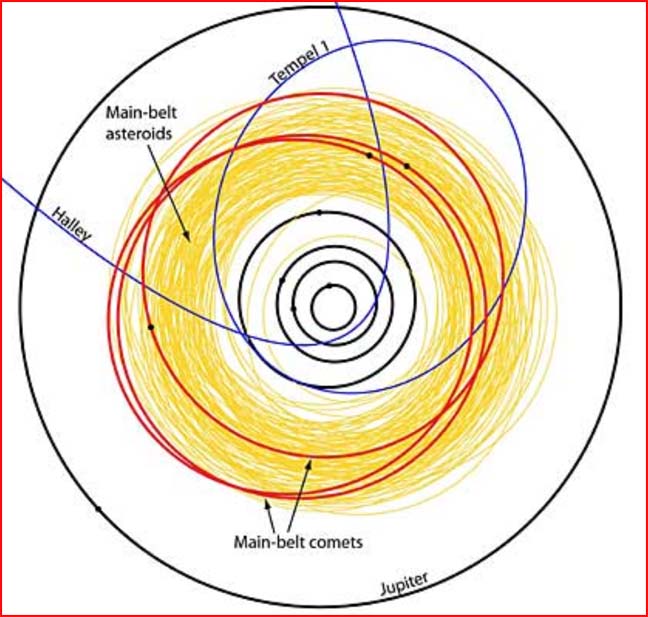
home •
about •
essential guide •
picture of the day •
thunderblogs •
news •
multimedia •
predictions •
products •
get involved •
contact
picture of the day archive subject index
Orbits of the three known main-belt comets (red lines), the five innermost planets (black lines; from the
center outward: Mercury, Venus, Earth, Mars,and Jupiter), a sample of 100 main-belt asteroids (orange lines),
and two "typical" comets (Halley's Comet, and Tempel 1, target of the recent Deep Impact mission) as blue lines. Positions of the main-belt comets and planets on March 1, 2006, are plotted with black dots. Image credit: Pedro Lacerda (Univ. Hawaii; Univ. Coimbra, Portugal)
Nov 09, 2006
When Asteroids Become Comets
The surprising discovery of asteroids with comet tails supports the longstanding claim of the electrical theorists—that the essential difference between asteroids and comets is the shape of their orbits.
According to a recent story in USA Today, astronomers are “rethinking long-held beliefs about the distant domains of comets and asteroids, abodes they've always considered light-years apart”. The discovery has forced astronomers to speculate that some asteroids are actually “dirty snowballs in disguise”.
For many years the standard view of asteroids asserted that they are composed of dust, rock, and metal and that most occupy a belt between Mars and Jupiter. In contrast, comets were claimed to arrive from a home in deep space, most coming from an imagined “Oort Cloud” at the outermost reaches of the solar system, where they are supposed to have accreted from leftover dust and ices from the formation of the solar system.
But now, “the locales of comets and asteroids may not be such a key distinction”, states Dan Vergano, reporting on the work of two University of Hawaii astronomers, Henry Hsieh and David Jewitt. In a survey of 300 asteroids lurking in the asteroid belt, the astronomers detected three objects that “look a lot like comets … ejecting little comet tails at times from their surfaces”. The three red circles in the illustration above describe the orbits of these bodies
Of course, this is not the first instance of an 'asteroid' sporting a cometary tail. The asteroid Chiron, orbiting between Saturn and Uranus, was seen to develop a coma and tail between 1988 and 1989. It is now officially classified as both an asteroid and a comet. Chiron belongs to a class of objects called 'Centaurs' crossing the orbits of various gas giants. Though they move on minimally eccentric orbits through a relatively remote and weak region of the Sun’s electric field, Wallace Thornhill and other electrical theorists believe these bodies should all be watched carefully for telltale signs of minor cometary activity. And in fact the asteroid 60558 Echeclus, discovered in 2000, did display a cometary coma detected in 2005, and it too is now classified as both an asteroid and a comet.
In the electric view, there is no fundamental distinction between a comet and an asteroid, apart from their orbits. Comets are not primordial objects formed by impact accretion – an improbable and unfalsifiable model (“it happened long, long ago and far, far away”). Asteroids, comets and meteorites are all 'born' in interplanetary electrical events. Their distinctive orbital groupings and spectral features simply point to separate catastrophic events and to different planetary bodies involved in different phases of solar system history.
A comet is simply an electrical display and was recognized as such by scientists in the 19th century. So an 'asteroid' on a sufficiently elliptical orbit will do precisely what a comet does—it will discharge electrically. What distinguishes the cometary 'asteroids', observed by the University of Hawaii astronomers, are the paths they follow, moving them through the radial electric field of the Sun to a greater extent than is typical of other bodies in the 'asteroid belt' (See chart above). Cometary effects may also be expected from an asteroid if it passes through the huge electric comet tail [called the magnetosphere] of a giant planet.
The astronomers’ recent investigation only reinforces the argument of the electrical theorists: The electric model is eminently testable, with highly specific and unique predictions; and it has so far met every test provided by the space age.
___________________________________________________________________________Please visit our Forum
The Electric Sky and The Electric Universe available now!

|
|

|
EXECUTIVE EDITORS:
David Talbott, Wallace Thornhill
MANAGING EDITORS:
Steve Smith, Mel Acheson
CONTRIBUTING EDITORS: Dwardu Cardona, Ev Cochrane,
C.J. Ransom, Don Scott, Rens van der Sluijs, Ian Tresman
WEBMASTER: Brian Talbott
Copyright 2006: thunderbolts.info
![]()
home •
thunderblogs •
forum •
picture of the day •
resources •
team •
updates •
contact us

